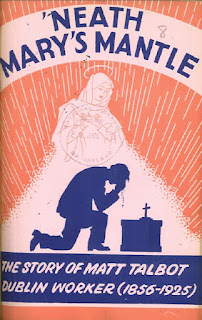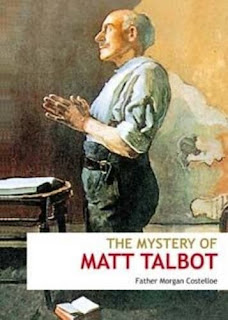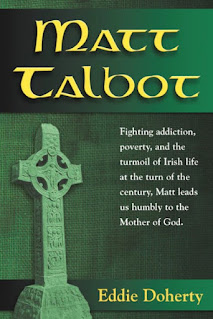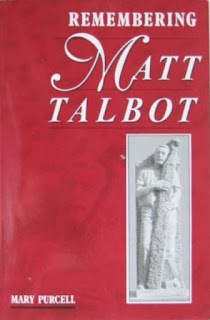‘Neath Mary's Mantle:
The Story of Matt Talbot Dublin Worker (1865-1925)
Rev Marius McAuliffe, OFM
Catholic Truth Society of Ireland
CTS Booklet BH361
1952
This is the tenth volume about Matt Talbot I have read in the last year. With each volume I tracked down and read I appreciate this man, his life, and his witness even more. Also with each volume I wish I had encountered this godly man and been praying to him before my brother overdosed. This is another excellent volume about Matt, it is from the Catholic Truth Society of Ireland and was published in 1952, 27 years after the passing of Matt, the quick spread of his life of piety, prayer and devotion that spread around the world in short order after his death. People often pray to him for those struggling with the drink, as Matt himself did, but he is also becoming a go to for intercession for other kinds of addictions. The subtitle of the book on the title page is:
“The life story of Matt Talbot – Franciscan Tertiary – Dublin Worker 1856-1925”
Even having already read a number of volumes about Matt I highlighted numerous passages while reading this book. Some of them are:
“Fourteen years of hard drinking no prayer, no Sacraments, just a routine attendance at the Sunday Mass - - that is the story of Matt Talbot till the day when, at the age of twenty-six, he broke forever with the reckless, shiftless, forlorn life of drunkard.”
“Hardened drunkard that he was, he begged, borrowed, pawned, and even stole to procure more drink. On the word of his mother, we know that often he had to walk home in his socks because he had sold the boots from his feet for drink. Once he stole a violin belonging to a wandering street musician. This he duly pawned and proceeded to treat himself and its owner to a night of drink. Years after, he vainly searched the streets of Dublin, hoping to find the violinist and pay back the money. Instead, by way of restitution, he had Masses offered for the spiritual and temporal welfare of the victim.”
“One thing was certain: here was the life of no common-place mortal. This happened over twenty-five years ago, Then the name, “Matt Talbot,” was just an entry in the casualty list of a busy city hospital. His death was just a trivial item in an obscure corner of the morning paper, pushed out of the way by wars and rumours of wars, the doings of statesmen, the clamour of stocks and shares, and the results of yesterday’s thrilled sports items.”
“Fanatic or sainted genius, the world asked in 1925, when it first heard the story of the man in chains. Today his story has encircled the world. His life, written by Sir Joseph Glynn, sold 10,000 copies in four days. The first few months saw 120,000 copies sold. Within a year it appeared in France, Germany (five editions), Portugal, Spain, Italy, Holland, Poland, Hungary, Czechoslovakia, Yugoslavia, Russia, and Brittany. Pilgrims from the wide world who foregathered in 1932 for the International Eucharistic Congress in Dublin made sure to visit the humble room where Matt lived; to see the spot where he fell in death, and to pray beside the humble grave in Glasnevin Cemetery. These included a great French Cardinal, who kissed the floor of the room where a great hero of God had lived his hidden life.”
“(A Rake’s Progress) “The picture which Matt presents to us at this period is that of a young fellow going fast on the road to ruin, the craving for drink gradually mastering him, the duties of his religion almost completely neglected, and the duties to his parents entirely ignored.””
“(Conversion) Here is the story of his conversion. It appears that about the year 1884, when he was in his twenty-fifth year, Matt spent a whole week away from work drinking. Naturally, on the Saturday he collected no wage. About midday he went out with a younger brother, hoping to meet his companions and he treated by them to drink. All he got was a nod of the head from a few, and ‘Good-day, Matt.” There was no invitation to drink.”
“What a revelation of his daily life are those words, “you’re sober!”
He answered simply. “Yes, mother, I am.”
But there was a bigger surprise in store for the poor woman. Later that Saturday afternoon he astounded her by saying, “I’m going to take the pledge.”
She must have wondered was this an answer to a mother’s prayers. However, she encouraged him by saying: “Go, in God’s Name; but don’t take it unless you are going to keep it.”
“I’ll go,” he answered, “in the Name of God.””
“(The Cloister of the Heart) Matt Talbot was no different. Actually, we are told, he “suffered intensely, for the craving for drink was strong in him and the effort to pray after so many years of neglect of prayer was very wearisome.””
“(The Tempter Foiled) So the three months went by. Matt was faithful to his pledged word, which he now renewed for a year, and later for life. Naturally, the priest to whom he had gone to Confession would have advised him to avoid the occasions of intemperance, and to seek strength in the Holy Sacrifice of the Mass and in frequent prayer. It awes hard to avoid the old company during the evenings, so he used to walk to a distant church, where he remained in prayer till it was time to return home to bed. He next joined the Confraternity of the Immaculate Conception at St. Francis Xavier’s Church, where his father was a member.”
“Like all truly spiritual men, Matt talked little of his inner life, and then only to kindred souls who know the value, the necessity of guarding the ‘secret of the King.” He had an original way of overcoming his bad habit of taking the Holy Name irreverently. He fixed two pins in the sleeve of his coat in the form of a Cross, so that he would be reminded of the Crucifixion, and thereby be helped to control his impulse of speaking irreverently.”
“(Devotion to the Mass) His day began with the Holy Sacrifice of the Mass and Holy Communion at 5 a.m. The Mass is to the church what the sun is to the world – the source of all energy.”
“At a late Mass after a night’s drunken carousal, with the now altered man that jumped from his warm bed at 4 o’clock on a very cold morning to undo the years of neglect by daily Mass. For over forty long years he was ever faithful to the daily Mass and Holy Communion. There, morning by morning, he took his place among the thronging worshippers of Dublin’s week-day congregation. There morning by morning, the silent hidden transformation went on within his soul – the world-weary spirit was renewed.”
“(The Daily Round) Rather, he lived prayer. Every opportunity that came during the day, such as slack periods between the loading of lorries, he gave to prayer. He used to retire to a quiet part of the timber yard, and there speak alone with God. Most of his lunch hour was occupied in this way. Then there were the visits to a church on his way to and from work.”
“His biographer tells us that amongst his regular prayers were the fifteen mysteries of the Rosary; the Little Office of the Blessed Virgin; the Dolour beads; the beads of the Holy Ghost; the beads of St. Michael; the beads of the Sacred Heart; the Chaplet for the souls in Purgatory; the principal Litanies; the prescribed novenas for each Church feast.”
“(Growing in Prayer) Matt was well aware of the distinction between ordinary prayer and mystical prayer or contemplation. Among his notes found after his death was the following, “In meditation, we labour to seek God, by reasoning and by good acts, but in contemplation we behold Him without labour, already found.” In meditation, the mind labours, operating with its power, but in contemplation it is God Himself Who operates and the soul merely receives the infused gifts.”
“He very rarely spoke of his prayer, but once he did say to his sister, “Susan, if I could only tell you the great joy I had last night talking to God and the Blessed Virgin.””
“(The oil of the Lamp of Prayer) Matt read for one purpose only, to know more about the purpose of his existence and how better to achieve the end. The list of books given to his biography gives us a clue to his mind. He read the very best spiritual classics beginning of course, with the Bible. He had collected a little library of these books and nothing delighted him more than to lend a book of speak to a confidant on the things he had read. These books ranged from booklets issued by the Catholic Truth Society to large and expensive books which he bought or which were presented to him.”
“(The Man Men Saw) Matt never married, though, indeed he once had a narrow escape from a would-be spouse, who did all the proposing herself! (Perhaps it was a Leap Year!) She was cook at the home of a Protestant clergyman, and was a good and pious girl. The attraction was mutual. He made a novena to Our Lady for enlightenment. The result was that he informed her that Our Lady told him he was never to marry.”
“(Matt “Downs Tools”) Yes, it is a fact that Matt “walked off the job.” He went out on strike. If he ever becomes a canonised saint he will probably have created a record by being the first saint ever to have ‘struck ‘against work. Through the years 1905-1913 there prevailed a period of industrial unrest, both in England and Ireland – strikes and locks-out were frequent. There is no need to go into the details here.”
“(Matt’s Humility) Matt saw all this clearly. He did not deny the greatness of the graces given. St. Teresa smiles pityingly at those who have the false humility to deny God’s graces. No! Humility is truth. Matt’s simple comment on his life was this: “It was God did it all.” No self-depreciation, no hiding of light under a bushel, no seeking of the world’s approval, no fear now of the world’s flattery – just the truth, “It was God did it all.” “
“(Unless Ye become as Little Children) Today his simple grave is a place of pilgrimage. The solitary who lived along with God, and was known in life to only a few, is now preached to the whole world. The saints are witnesses to the truth. They are signposts on the road of life. They point the way to better things. Long ago, St. Augustine declared that “the ignorant and unlettered arc storming Heaven, while we, with all our learning, lie grovelling in the mud.” Matt phrased the Gospel text in his own homely way when he wrote: “The Kingdom of Heaven was promised not to the sensible and educated, but to those that possess the spirit of little children.””
I hope those quotes give you a feel for this wonderful volume. I can easily recommend this volume and many of the others I have read. Some of them are hard to track down. This one I received from the National Library of Ireland through their scanning service. I am thankful I tracked it down and was able to read it. I try and say 2 different prayers to Matt every day. And with each volume I read about him, I am encouraged and strengthened in my own prayer life and in striving to become the man God wants me to be. I can easily recommend this volume to any Catholic, it is well worth tracking down and reading.
Note: This book is part of a series of reviews: 2024 Catholic Reading Plan!
For all reviews of books about Matt Talbot Click here.
Books about Matt Talbot:
Matt Talbot and His Times - Mary Purcell
Matt Talbot: His Struggle, His Victory over Alcoholism - Susan Helen Wallace
Matt Talbot - Xavier Carty
Spotlight on Matt Talbot - Edward O'Connor, S.J.
Matt Talbot - Simon O'Brynne
The quest for Matt Talbot - Philip Rooney
We knew Matt Talbot - Albert H Dolan
Matt Talbot - James F. Cassidy.
An address to Pope John Paul II from the Parish of Matt Talbot, The Worker.
Matt Talbot : the Irish worker's glory - James Francis Cassidy
Matt Talbot - Albon White
The Story of Matt Talbot - Malachy Gerard Carroll














No comments:
Post a Comment